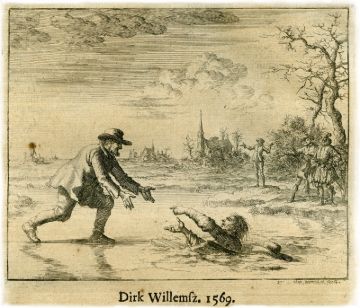Zweierlei Rettung - Two kinds of rescue
In winter of 1569, Dirk Willems, a Dutch Anabaptist managed to escape from prison after having been sentenced to death shortly before. As he attempted to escape from his authoritative henchmen and make his way across the frozen canals, the ice cracked behind him under the weight of his pursuer.
Dirk Willems hesitated whether he should thank God for this miraculous rescue. He decided otherwise, turned back, pulled the drowning "Anabaptist hunter" out of the cold waters and snatched him from certain death. But instead of granting him freedom out of gratitude, Dirk Willems was immediately arrested again and even executed a short time later.
More information:
The biblical message of peace and reconciliation was central to many Anabaptist communities. What it could mean to love even "the enemy" and "not to repay evil with evil, but to try to overcome it with good"-this is what the Dutch Anabaptist Dirk Willems experienced firsthand.

Dirk Willems sauve son poursuivant.
(Gravure de Jan Luyken dans le Miroir des Martyrs).
"In the bitterly cold winter of 1569, he managed to escape from prison after having been sentenced to death shortly before. As he attempted to escape from his authoritative henchmen and make his way across the frozen canals, the ice cracked behind him under the weight of his pursuer.
Dirk Willems hesitated whether he should thank God for this miraculous rescue. He decided otherwise, turned back, pulled the drowning "Anabaptist hunter" out of the cold waters and snatched him from certain death. But instead of granting him freedom out of gratitude, Dirk Willems was immediately arrested again and even executed a short time later."[1]
The illustration by Jan Luyken [1649-1712] is not only one of the most moving pictorial representations of the Anabaptist story: it has since challenged and inspired numerous generations worldwide to reflect on a life of renunciation of violence and Christian witness to peace - and on the price one was willing to pay for it.[2]
[1] From: Thieleman J. van Braght, Het Bloedig Tooneel, of Martelerezers Spiegel der Doops-Gesinde of Weereloose Christenen, AMSTERDAM 1685. (Dt. Version: Der blutige Schauplatz oder Märtyrerspiegel der Taufgesinnten oder wehrlosen Christen. Ephrata 1748 / Pirmasens 1780). Illustration von Jan Luyken [1649–1712].
[2] Vgl. zu einer kritischen Auseinandersetzung mit dem Thema : Ian Huebert, Kevin Enns-Rempel, John Blosser: Views from a pond: the Dirk Willems variations. What might Dirk have done? Mirror for reluctant martyrs, in: Pacific Journal 4 (2009): 1-11 (URL: http://hdl.handle.net/11418/442).



